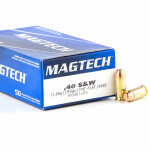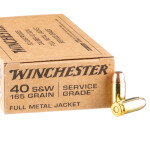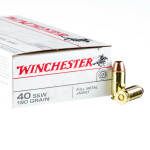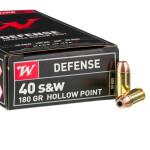Bulk .40 S&W Ammo
.40 S&W Ammunition
Origins of 40 Smith & Wesson Ammo
A partnership of both Smith & Wesson and Winchester led to the development of .40 Smith & Wesson ammunition with the round making its debut in 1990. Introduced as a round that could nearly replicate the performance of the 10mm round that was used by the Federal Bureau of Investigation at the time in a smaller package, the round packs more muzzle velocity into a package that’s nearly as small as a 9mm cartridge.
[Read More]-
 500 Rounds of .40 S&W Ammo by Winchester - 165gr FMJ
500 Rounds of .40 S&W Ammo by Winchester - 165gr FMJ
Regular Price: $154
On Sale: $139
101 Ready to Ship
-
 500 Rounds of .40 S&W Ammo by Winchester - 165gr FMJ
$149
500 Rounds of .40 S&W Ammo by Winchester - 165gr FMJ
$14988 Ready to Ship
-
 600 Rounds of .40 S&W Ammo by Winchester - 165gr FMJ
$179
600 Rounds of .40 S&W Ammo by Winchester - 165gr FMJ
$17924 Ready to Ship
-
 500 Rounds of .40 S&W Ammo by Winchester Service Grade - 165gr FMJ
$154
500 Rounds of .40 S&W Ammo by Winchester Service Grade - 165gr FMJ
$154111 Ready to Ship
-
 1000 Rounds of .40 S&W Ammo by Fiocchi - 170gr FMJ
$309
1000 Rounds of .40 S&W Ammo by Fiocchi - 170gr FMJ
$3097 Ready to Ship
-
 500 Rounds of .40 S&W Ammo by Winchester - 180gr FMJ
$159
500 Rounds of .40 S&W Ammo by Winchester - 180gr FMJ
$159103 Ready to Ship
-
 500 Rounds of .40 S&W Ammo by BVAC - Remanfactured - 180gr FMJ
$160
500 Rounds of .40 S&W Ammo by BVAC - Remanfactured - 180gr FMJ
$16085 Ready to Ship
-
 1000 Rounds of .40 S&W Ammo by Sellier & Bellot - 180gr FMJ
$334
1000 Rounds of .40 S&W Ammo by Sellier & Bellot - 180gr FMJ
$33423 Ready to Ship
-
 1000 Rounds of .40 S&W Ammo by Magtech - 180gr FMJ
$339
1000 Rounds of .40 S&W Ammo by Magtech - 180gr FMJ
$33943 Ready to Ship
-
 1000 Rounds of .40 S&W Ammo by Speer - 180gr TMJ
$344
1000 Rounds of .40 S&W Ammo by Speer - 180gr TMJ
$34419 Ready to Ship
-
 1000 Rounds of .40 S&W Ammo by Federal - 180gr FMJ
$345
1000 Rounds of .40 S&W Ammo by Federal - 180gr FMJ
$34510 Ready to Ship
-
 100 Rounds of .40 S&W Ammo by Winchester - 165gr FMJ
$34.50
100 Rounds of .40 S&W Ammo by Winchester - 165gr FMJ
$34.5092 Ready to Ship
-
 1000 Rounds of .40 S&W Ammo by PMC - 180gr FMJFN
$349
1000 Rounds of .40 S&W Ammo by PMC - 180gr FMJFN
$34910 Ready to Ship
-
 1000 Rounds of .40 S&W Ammo by Blazer Brass - 165gr FMJ
$350
1000 Rounds of .40 S&W Ammo by Blazer Brass - 165gr FMJ
$35039 Ready to Ship
-
 50 Rounds of .40 S&W Ammo by Winchester - 165gr FMJ
$17.55
50 Rounds of .40 S&W Ammo by Winchester - 165gr FMJ
$17.5544 Ready to Ship
-
 1000 Rounds of .40 S&W Ammo by Blazer Brass - 180gr FMJ
$354
1000 Rounds of .40 S&W Ammo by Blazer Brass - 180gr FMJ
$35447 Ready to Ship
-
 50 Rounds of .40 S&W Ammo by Winchester Service Grade - 165gr FMJ
$17.75
50 Rounds of .40 S&W Ammo by Winchester Service Grade - 165gr FMJ
$17.7554 Ready to Ship
-
 1000 Rounds of .40 S&W Ammo by Federal - 165gr FMJ
$359
1000 Rounds of .40 S&W Ammo by Federal - 165gr FMJ
$3592 Ready to Ship
-
 1000 Rounds of .40 S&W Clean-Fire Ammo by Speer - 180gr TMJ
$359
1000 Rounds of .40 S&W Clean-Fire Ammo by Speer - 180gr TMJ
$3599 Ready to Ship
-
 1000 Rounds of .40 S&W Ammo by Magtech - 165gr FMJ FN
$359
1000 Rounds of .40 S&W Ammo by Magtech - 165gr FMJ FN
$3593 Ready to Ship
-
 50 Rounds of .40 S&W Ammo by Fiocchi - 170gr FMJ
$18.25
50 Rounds of .40 S&W Ammo by Fiocchi - 170gr FMJ
$18.254 Ready to Ship
-
 1000 Rounds of .40 S&W Ammo by Speer - 165gr TMJ
$369
1000 Rounds of .40 S&W Ammo by Speer - 165gr TMJ
$3698 Ready to Ship
-
 1000 Rounds of .40 S&W Ammo by PMC - 165gr FMJFN
$369
1000 Rounds of .40 S&W Ammo by PMC - 165gr FMJFN
$3699 Ready to Ship
-
 50 Rounds of .40 S&W Ammo by Winchester - 180gr FMJ
$18.50
50 Rounds of .40 S&W Ammo by Winchester - 180gr FMJ
$18.50129 Ready to Ship
-
 50 Rounds of .40 S&W Ammo by Magtech - 180gr FMJ
$19.50
50 Rounds of .40 S&W Ammo by Magtech - 180gr FMJ
$19.5031 Ready to Ship
-
 50 Rounds of .40 S&W Ammo by Blazer Brass - 180gr FMJ
$19.50
50 Rounds of .40 S&W Ammo by Blazer Brass - 180gr FMJ
$19.5034 Ready to Ship
-
 50 Rounds of .40 S&W Ammo by PMC - 165gr FMJFN
$19.50
50 Rounds of .40 S&W Ammo by PMC - 165gr FMJFN
$19.50116 Ready to Ship
-
 900 Rounds of .40 S&W Ammo by PMC Battle Packs - 165gr FMJ FP
$354
900 Rounds of .40 S&W Ammo by PMC Battle Packs - 165gr FMJ FP
$3542 Ready to Ship
-
 1000 Rounds of .40 S&W Ammo by Remington - 180gr MC
$395
1000 Rounds of .40 S&W Ammo by Remington - 180gr MC
$3951 Ready to Ship
-
 50 Rounds of .40 S&W Ammo by Blazer Brass - 165gr FMJ
$19.75
50 Rounds of .40 S&W Ammo by Blazer Brass - 165gr FMJ
$19.7552 Ready to Ship
-
 50 Rounds of .40 S&W Ammo by PMC - 180gr FMJFN
$19.75
50 Rounds of .40 S&W Ammo by PMC - 180gr FMJFN
$19.7541 Ready to Ship
-
 500 Rounds of .40 S&W Ammo by Winchester - 180gr JHP
$199
500 Rounds of .40 S&W Ammo by Winchester - 180gr JHP
$19916 Ready to Ship

.40 SW Bullets – Your Options
 Generally, shooters will prefer to fire full metal jacket (FMJ) rounds for range training. These rounds have a bullet that is not designed to expand upon impact with a target. Because they are relatively unsophisticated in their design, these “ball” rounds are generally cheaper than the projectiles that are used for self-defense.
Generally, shooters will prefer to fire full metal jacket (FMJ) rounds for range training. These rounds have a bullet that is not designed to expand upon impact with a target. Because they are relatively unsophisticated in their design, these “ball” rounds are generally cheaper than the projectiles that are used for self-defense.
For self-defense, look for jacketed hollow point (JHP) .40 S&W ammo. Rounds like Federal’s HST ammo, Remington’s Golden Saber or Winchester’s Defender series are all good choices for shooters looking for defensive ammunition.
180-grain is generally considered the standard weight for 40 Smith & Wesson bullets but you’ll also find .40 S&W ammo in-stock in 165-grain weights often as well. Of course, the 165-grain bullet travels faster than the 180-grain bullet and many shooters believe a 165 grain 40 S&W has lighter recoil, allowing for faster retargeting after firing.
The Round in Use Today
.40 cal ammo is still very common among shooters today and is one of the more modern rounds available to American civilian shooters.
While the Federal Bureau of Investigation and other law enforcement agencies have backed off on the round because of its recoil, 40 S&W is still common among special operations units and the United States Coast Guard.




